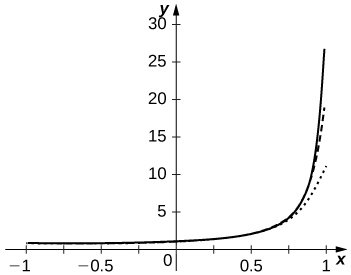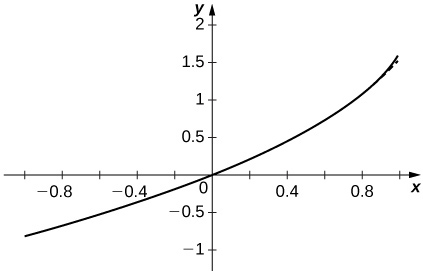10.1E: Exercises for Section 10.1
( \newcommand{\kernel}{\mathrm{null}\,}\)
In exercises 1 - 4, state whether each statement is true, or give an example to show that it is false.
1) If ∞∑n=1anxn converges, then anxn→0 as n→∞.
- Answer
- True. If a series converges then its terms tend to zero.
2) ∞∑n=1anxn converges at x=0 for any real numbers an.
3) Given any sequence an, there is always some R>0, possibly very small, such that ∞∑n=1anxn converges on (−R,R).
- Answer
- False. It would imply that anxn→0 for |x|<R. If an=nn, then anxn=(nx)n does not tend to zero for any x≠0.
4) If ∞∑n=1anxn has radius of convergence R>0 and if |bn|≤|an| for all n, then the radius of convergence of ∞∑n=1bnxn is greater than or equal to R.
5) Suppose that ∞∑n=0an(x−3)n converges at x=6. At which of the following points must the series also converge? Use the fact that if ∑an(x−c)n converges at x, then it converges at any point closer to c than x.
a. x=1
b. x=2
c. x=3
d. x=0
e. x=5.99
f. x=0.000001
- Answer
- It must converge on (0,6] and hence at: a. x=1; b. x=2; c. x=3; d. x=0; e. x=5.99; and f. x=0.000001.
6) Suppose that ∞∑n=0an(x+1)n converges at x=−2. At which of the following points must the series also converge? Use the fact that if ∑an(x−c)n converges at x, then it converges at any point closer to c than x.
a. x=2
b. x=−1
c. x=−3
d. x=0
e. x=0.99
f. x=0.000001
In the following exercises, suppose that |an+1an|→1 as n→∞. Find the radius of convergence for each series.
7) ∞∑n=0an2nxn
- Answer
- |an+12n+1xn+1an2nxn|=2|x||an+1an|→2|x| so R=12
8) ∞∑n=0anxn2n
9) ∞∑n=0anπnxnen
- Answer
- |an+1(πe)n+1xn+1an(πe)nxn|=π|x|e|an+1an|→π|x|e so R=eπ
10) ∞∑n=0an(−1)nxn10n
11) ∞∑n=0an(−1)nx2n
- Answer
- |an+1(−1)n+1x2n+2an(−1)nx2n|=|x2||an+1an|→|x2| so R=1
12) ∞∑n=0an(−4)nx2n
In exercises 13 - 22, find the radius of convergence R and interval of convergence for ∑anxn with the given coefficients an.
13) ∞∑n=1(2x)nn
- Answer
- an=2nn so an+1xan→2x. so R=12. When x=12 the series is harmonic and diverges. When x=−12 the series is alternating harmonic and converges. The interval of convergence is I=[−12,12).
14) ∞∑n=1(−1)nxn√n
15) ∞∑n=1nxn2n
- Answer
- an=n2n so an+1xan→x2 so R=2. When x=±2 the series diverges by the divergence test. The interval of convergence is I=(−2,2).
16) ∞∑n=1nxnen
17) ∞∑n=1n2xn2n
- Answer
- an=n22n so R=2. When x=±2 the series diverges by the divergence test. The interval of convergence is I=(−2,2).
18) ∞∑k=1kexkek
19) ∞∑k=1πkxkkπ
- Answer
- ak=πkkπ so R=1π. When x=±1π the series is an absolutely convergent p-series. The interval of convergence is I=[−1π,1π].
20) ∞∑n=1xnn!
21) ∞∑n=110nxnn!
- Answer
- an=10nn!,an+1xan=10xn+1→0<1 so the series converges for all x by the ratio test and I=(−∞,∞).
22) ∞∑n=1(−1)nxnln(2n)
In exercises 23 - 28, find the radius of convergence of each series.
23) ∞∑k=1(k!)2xk(2k)!
- Answer
- ak=(k!)2(2k)! so ak+1ak=(k+1)2(2k+2)(2k+1)→14 so R=4
24) ∞∑n=1(2n)!xnn2n
25) ∞∑k=1k!1⋅3⋅5⋯(2k−1)xk
- Answer
- ak=k!1⋅3⋅5⋯(2k−1) so ak+1ak=k+12k+1→12 so R=2
26) ∞∑k=12⋅4⋅6⋯2k(2k)!xk
27) ∞∑n=1xn(2nn) where (nk)=n!k!(n−k)!
- Answer
- an=1(2nn) so an+1an=((n+1)!)2(2n+2)!2n!(n!)2=(n+1)2(2n+2)(2n+1)→14 so R=4
28) ∞∑n=1sin2nxn
In exercises 29 - 32, use the ratio test to determine the radius of convergence of each series.
29) ∞∑n=1(n!)3(3n)!xn
- Answer
- an+1an=(n+1)3(3n+3)(3n+2)(3n+1)→127 so R=27
30) ∞∑n=123n(n!)3(3n)!xn
31) ∞∑n=1n!nnxn
- Answer
- an=n!nn so an+1an=(n+1)!n!nn(n+1)n+1=(nn+1)n→1e so R=e
32) ∞∑n=1(2n)!n2nxn
In the following exercises, given that 11−x=∞∑n=0xn with convergence in (−1,1), find the power series for each function with the given center a, and identify its interval of convergence.
33) f(x)=1x;a=1 (Hint: 1x=11−(1−x))
- Answer
- f(x)=∞∑n=0(1−x)n on I=(0,2)
34) f(x)=11−x2;a=0
35) f(x)=x1−x2;a=0
- Answer
- ∞∑n=0x2n+1 on I=(−1,1)
36) f(x)=11+x2;a=0
37) f(x)=x21+x2;a=0
- Answer
- ∞∑n=0(−1)nx2n+2 on I=(−1,1)
38) f(x)=12−x;a=1
39) f(x)=11−2x;a=0.
- Answer
- ∞∑n=02nxn on (−12,12)
40) f(x)=11−4x2;a=0
41) f(x)=x21−4x2;a=0
- Answer
- ∞∑n=04nx2n+2 on (−12,12)
42) f(x)=x25−4x+x2;a=2
Use the result of exercise 43 to find the radius of convergence of the given series in the subsequent exercises (44 - 47).
43) Explain why, if |an|1/n→r>0, then |anxn|1/n→|x|r<1 whenever |x|<1r and, therefore, the radius of convergence of ∞∑n=1anxn is R=1r.
- Answer
- |anxn|1/n=|an|1/n|x|→|x|r as n→∞ and |x|r<1 when |x|<1r. Therefore, ∞∑n=1anxn converges when |x|<1r by the nth root test.
44) ∞∑n=1xnnn
45) ∞∑k=1(k−12k+3)kxk
- Answer
- ak=(k−12k+3)k so (ak)1/k→12<1 so R=2
46) ∞∑k=1(2k2−1k2+3)kxk
47) ∞∑n=1an=(n1/n−1)nxn
- Answer
- an=(n1/n−1)n so (an)1/n→0 so R=∞
48) Suppose that p(x)=∞∑n=0anxn such that an=0 if n is even. Explain why p(x)=p(−x).
49) Suppose that p(x)=∞∑n=0anxn such that an=0 if n is odd. Explain why p(x)=−p(−x).
- Answer
- We can rewrite p(x)=∞∑n=0a2n+1x2n+1 and p(x)=p(−x) since x2n+1=−(−x)2n+1.
50) Suppose that p(x)=∞∑n=0anxn converges on (−1,1]. Find the interval of convergence of p(Ax).
51) Suppose that p(x)=∞∑n=0anxn converges on (−1,1]. Find the interval of convergence of p(2x−1).
- Answer
- If x∈[0,1], then y=2x−1∈[−1,1] so p(2x−1)=p(y)=∞∑n=0anyn converges.
In the following exercises, suppose that p(x)=∞∑n=0anxn satisfies limn→∞an+1an=1 where an≥0 for each n. State whether each series converges on the full interval (−1,1), or if there is not enough information to draw a conclusion. Use the comparison test when appropriate.
52) ∞∑n=0anx2n
53) ∞∑n=0a2nx2n
- Answer
- Converges on (−1,1) by the ratio test
54) ∞∑n=0a2nxn (Hint:x=±√x2)
55) ∞∑n=0an2xn2 (Hint: Let bk=ak if k=n2 for some n, otherwise bk=0.)
- Answer
- Consider the series ∑bkxk where bk=ak if k=n2 and bk=0 otherwise. Then bk≤ak and so the series converges on (−1,1) by the comparison test.
56) Suppose that p(x) is a polynomial of degree N. Find the radius and interval of convergence of ∞∑n=1p(n)xn.
57) [T] Plot the graphs of 11−x and of the partial sums SN=N∑n=0xn for n=10,20,30 on the interval [−0.99,0.99]. Comment on the approximation of 11−x by SN near x=−1 and near x=1 as N increases.
- Answer
-
The approximation is more accurate near x=−1. The partial sums follow 11−x more closely as N increases but are never accurate near x=1 since the series diverges there.

58) [T] Plot the graphs of −ln(1−x) and of the partial sums SN=N∑n=1xnn for n=10,50,100 on the interval [−0.99,0.99]. Comment on the behavior of the sums near x=−1 and near x=1 as N increases.
59) [T] Plot the graphs of the partial sums Sn=N∑n=1xnn2 for n=10,50,100 on the interval [−0.99,0.99]. Comment on the behavior of the sums near x=−1 and near x=1 as N increases.
- Answer
-
The approximation appears to stabilize quickly near both x=±1.

60) [T] Plot the graphs of the partial sums SN=N∑n=1(sinn)xn for n=10,50,100 on the interval [−0.99,0.99]. Comment on the behavior of the sums near x=−1 and near x=1 as N increases.
61) [T] Plot the graphs of the partial sums SN=N∑n=0(−1)nx2n+1(2n+1)! for n=3,5,10 on the interval [−2π,2π]. Comment on how these plots approximate sinx as N increases.
- Answer
-
The polynomial curves have roots close to those of sinx up to their degree and then the polynomials diverge from sinx.

62) [T] Plot the graphs of the partial sums SN=N∑n=0(−1)nx2n(2n)! for n=3,5,10 on the interval [−2π,2π]. Comment on how these plots approximate cosx as N increases.
Contributors
Gilbert Strang (MIT) and Edwin “Jed” Herman (Harvey Mudd) with many contributing authors. This content by OpenStax is licensed with a CC-BY-SA-NC 4.0 license. Download for free at http://cnx.org.


